You've likely encountered camouflage fabric in various settings, from military uniforms to hunting gear and even fashion statements. This specialized textile combines strategic patterns, colors, and materials to help users blend with their environment. While its primary purpose remains concealment, modern camouflage has evolved far beyond simple green and brown splotches. To fully grasp this versatile material's impact, you'll need to understand its complex development, varied applications, and technical specifications.
Key Takeaways
- Camouflage fabric features specialized patterns and colors designed to help wearers blend into specific environments like woodlands, deserts, or urban areas.
- Common materials include cotton, polyester, and ripstop nylon, chosen for durability and ability to maintain detailed print patterns.
- Military-grade camouflage incorporates disruptive coloration and irregular shapes, meeting strict specifications for concealment and performance in combat situations.
- Different types include woodland (greens and browns), desert (tans), and digital (pixelated) patterns, each optimized for specific terrain.
- Beyond military use, camouflage fabric serves practical applications in hunting gear, outdoor clothing, and modern interior design elements.
Understanding Camouflage Fabric
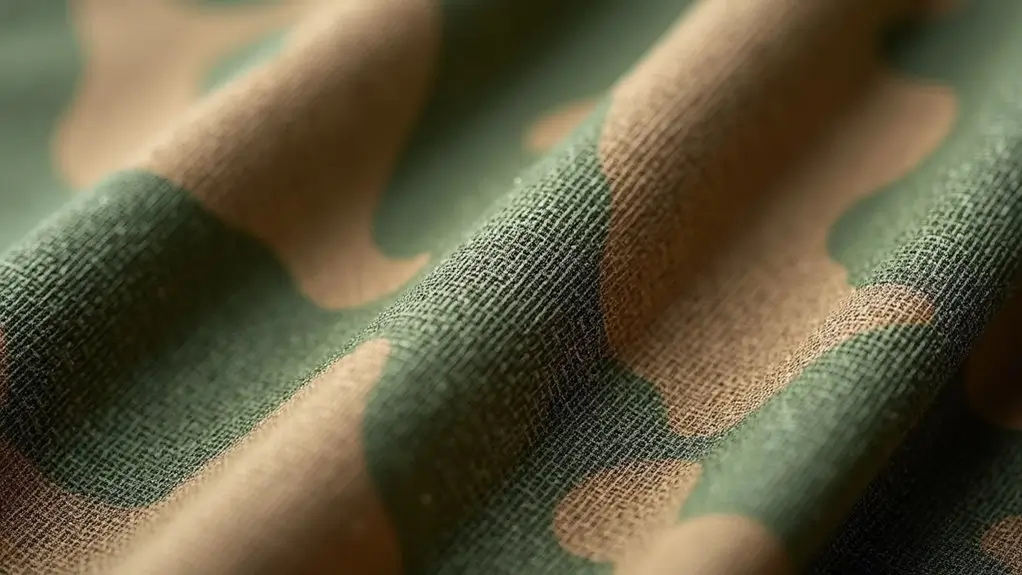
Camouflage fabric consists of specialized textile materials featuring distinct patterns designed to help objects or people blend into specific environments.
You'll find various types of camouflage prints, including digital, woodland, desert, and urban patterns, each engineered for ideal concealment in different terrains.
The most common materials used in manufacturing camouflage fabric include cotton, polyester, ripstop nylon, and cotton-polyester blends, each chosen for their durability, comfort, and ability to hold detailed print patterns.
What is Camo Fabric
Military-grade textiles designed with concealment patterns represent the core definition of camo fabric - a specialized material that incorporates disruptive coloration and irregular shapes to break up the wearer's visual outline.
The fabric features that define camouflage print include:
- Specialized dye treatments that create distinct pattern variations using multiple color combinations.
- Durable material construction engineered to military specifications for tactical applications.
- Strategic placement of irregular shapes and organic patterns that mimic natural environments.
- Advanced textile technologies that enhance the camouflage fabric's ability to blend with surroundings while maintaining essential performance characteristics like durability, breathability, and weather resistance.
Types of Camouflage Prints
While the basic concept of concealment remains constant, modern camouflage prints have evolved into distinct categories that serve specific operational environments and tactical needs.
You'll find woodland camouflage featuring irregular patterns of green, brown, and black, designed for forested areas.
Desert patterns incorporate beige and tan tones for arid environments.
Digital camouflage uses pixelated squares to break up the wearer's outline, while digital camo variants adapt to specific terrains.
Army camouflage patterns blend multiple camouflage designs into one versatile pattern.
Each camouflage pattern is scientifically engineered to maximize concealment in its intended environment.
Common Materials in Camouflage Fabric
The production of modern camouflage fabric relies on several key textile materials, each selected for specific performance characteristics.
You'll find these materials chosen for their unique properties in military and civilian applications:
- Ripstop fabric - Features reinforced threading that prevents tears from spreading, creating a highly durable woven fabric.
- Cotton blends - Provide breathability and comfort while maintaining strength.
- Polyester combinations - Offer moisture-wicking properties and color retention.
- Waterproof synthetics - Incorporate specialized coatings for weather resistance.
These materials are often combined to create ideal blends that balance durability, comfort, and functionality in various environmental conditions.
Types of Camouflage Fabric
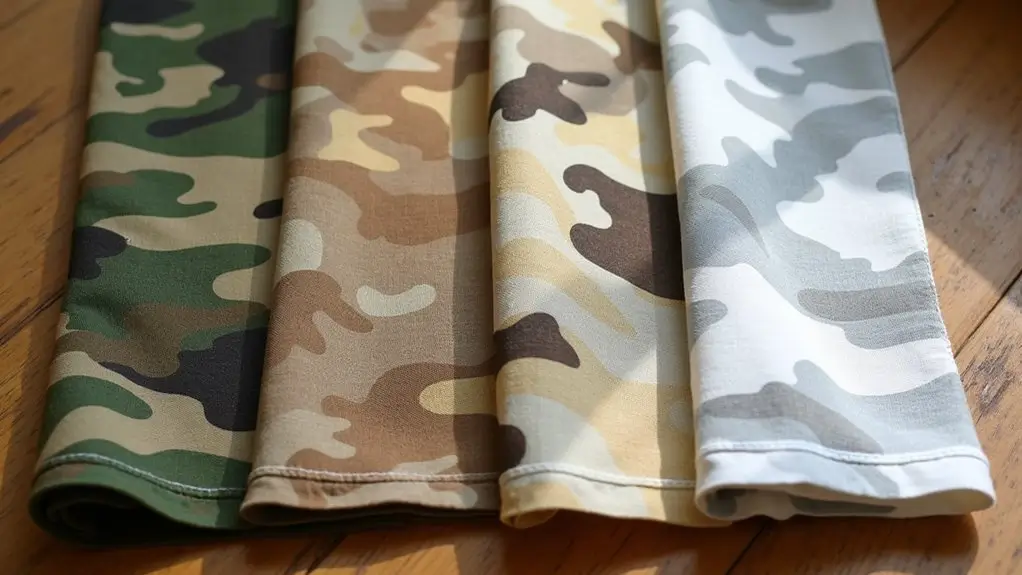
When comparing military camouflage fabrics, you'll encounter two main categories: digital patterns that use pixel-like shapes to break up outlines, and traditional patterns featuring organic shapes like foliage and rocks.
You'll find woodland camouflage incorporating greens and browns in irregular patterns, which proves especially effective in forested environments and jungle warfare scenarios.
Desert and urban camouflage patterns utilize lighter tans, grays, and geometric shapes to match arid landscapes and cityscapes, respectively, with specialized variations for different operational environments.
Digital Camouflage vs. Traditional Camouflage
Modern digital camouflage patterns differ markedly from their traditional counterparts through pixelated geometric shapes instead of organic, flowing designs.
You'll find this advancement in military apparel has revolutionized concealment technology.
- Digital patterns use micro-squares to break up outlines more effectively than traditional green and brown swirls.
- Computer-generated pixels create more realistic depth perception in varied terrains than classic hunter prints.
- Army research shows digital camouflage provides 40% better concealment at various distances.
- Traditional patterns rely on natural shapes like leaves and branches, while digital versions use mathematical algorithms.
These scientific approaches to concealment demonstrate the evolution from artistic to data-driven camouflage design.
Woodland Camouflage and Its Applications
Designed for temperate forests and vegetated environments, woodland camouflage incorporates overlapping patterns of green, brown, and black to mimic natural foliage.
You'll find this versatile pattern available as camo fabric by the yard, often featuring camouflage ripstop construction for enhanced durability.
This pattern excels in outdoor applications, particularly for hunting gear and lightweight jackets. The irregular shapes and shadowing effects help break up your silhouette among trees and underbrush.
When selecting outdoor apparel, woodland camo proves most effective during spring and summer seasons. The pattern's success has made it a standard choice for military, tactical, and recreational gear worldwide.
Desert and Urban Camouflage Patterns
Desert and urban environments demand distinctly different camouflage approaches than woodland settings. You'll find these unique patterns engineered for maximum utility in arid and metropolitan landscapes.
- Desert camouflage fabric features light tan, beige, and sand colors that break up your silhouette against dunes and rocky terrain.
- Urban patterns incorporate varied gray tones and geometric shapes to match concrete structures.
- Both styles use lightweight, versatile materials designed for hot climates and rough wear.
- Color gradients shift between light and dark shades to disrupt visual recognition in changing light conditions.
These specialized patterns help you blend seamlessly into their respective environments while maintaining tactical effectiveness.
Characteristics of Camouflage Fabric
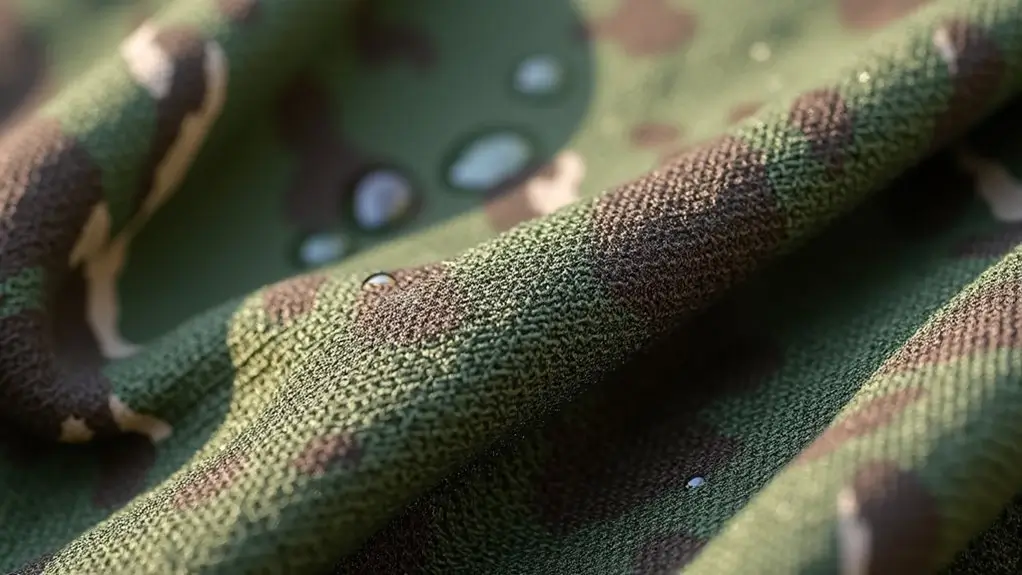
You'll find that modern camouflage fabrics offer a range of performance characteristics, from fully waterproof membranes to water-resistant coatings that suit different environmental conditions and usage requirements.
The weight of these materials varies considerably, with lightweight options around 4-6 ounces per square yard for warm weather use and heavyweight variants exceeding 8 ounces for durability and cold weather protection.
These technical textiles often incorporate elastane or spandex for 2-way or 4-way stretch, while featuring moisture-wicking properties and breathable mesh panels that maintain comfort during active use.
Waterproof and Water-Resistant Options
Many camouflage fabrics incorporate specialized waterproof or water-resistant treatments to enhance their performance in wet conditions.
You'll find these weather-resistant materials commonly used in outdoor gear where protection from the elements is vital.
- Waterproof canvas provides complete water blockage, making it perfect for utility items like rain coats and heavy-duty covers.
- Water-resistant treatments offer moderate protection while maintaining fabric flexibility.
- Breathable membranes allow moisture vapor to escape while preventing water penetration.
- DWR (Durable Water Repellent) coatings create a water-beading surface that keeps you dry without compromising the fabric's camouflage properties.
These specialized treatments guarantee your gear remains functional in challenging weather conditions.
Lightweight vs. Heavyweight Camouflage Fabrics
When selecting camouflage fabric, understanding the distinct characteristics between lightweight and heavyweight options becomes essential for specific operational needs.
Lightweight fabrics (2-6 oz/yd²) offer enhanced mobility and breathability, ideal for warm-weather operations. You'll find these soft, pliable materials perfect for base layers and summer garments.
Heavyweight options (7-12 oz/yd²) provide durability and protection against harsh environments, though they'll restrict movement more than lighter alternatives.
Medium weight twill (6-8 oz/yd²) strikes a balance between comfort and durability, making it popular for standard-issue uniforms.
Consider your climate and activity level when choosing between these fabric weights.
Stretch and Breathability in Camouflage Materials
Beyond fabric weight considerations, stretch and breathability capabilities determine the overall performance of camouflage materials in tactical scenarios.
You'll find various fabrics engineered specifically for maximum mobility and ventilation:
- Knit fabric construction offers four-way stretch, making it ideal for form-fitting tactical wear.
- Mesh panels strategically placed in high-heat areas enhance breathability while maintaining concealment.
- Jersey knit fabric provides natural elasticity and moisture-wicking properties essential for extended operations.
- Specialized weave patterns incorporate elastic fibers that allow unrestricted movement without compromising durability.
These technical features guarantee you maintain stealth and comfort during tactical missions, regardless of environmental conditions or physical demands.
Applications of Camouflage Fabric
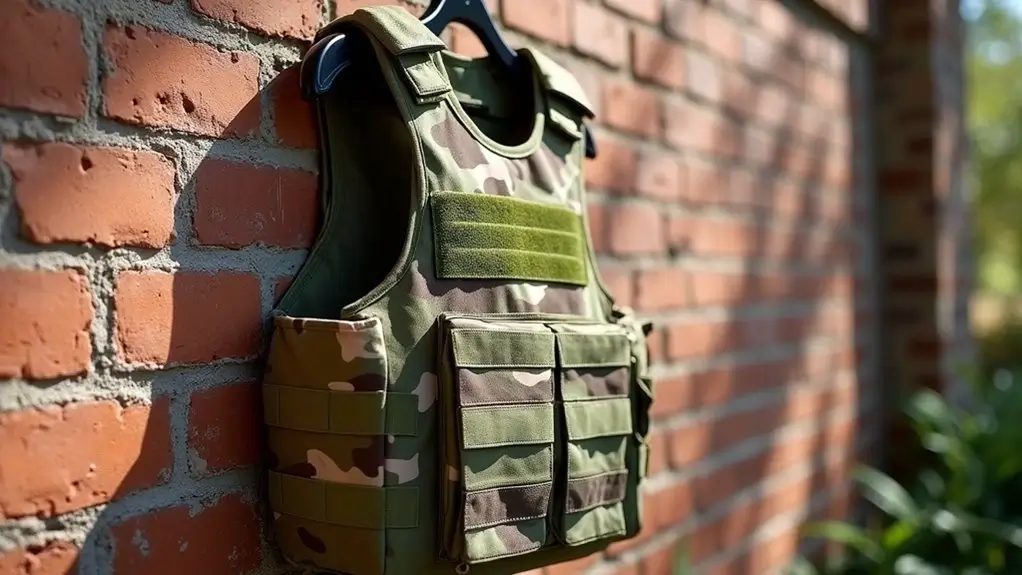
You'll find camouflage fabric extensively used in military uniforms, tactical vests, and combat gear where concealment is mission-critical.
The outdoor recreation sector incorporates this versatile material into hunting apparel, backpacks, and camping equipment to help enthusiasts blend with natural surroundings.
Beyond its traditional concealment purposes, you'll encounter camouflage fabric in contemporary interior design, serving as an aesthetic choice for furniture upholstery, throw pillows, and decorative accessories.
Military and Tactical Gear
Military and tactical gear represents one of the most critical applications for camouflage fabric, encompassing everything from combat uniforms to equipment covers and load-bearing vests.
The type of apparel you'll find in military use includes:
- Combat suits with bold camouflage patterns designed for specific environments
- Tactical jackets with specialized pockets and reinforced wear points
- All-weather coats featuring waterproof camouflage materials
- Load-bearing vests with modular attachment systems
These specialized garments incorporate advanced fabric technologies that enhance durability while maintaining effective concealment.
You'll find these materials engineered to specific military standards, offering superior performance in challenging operational environments.
Outdoor Apparel for Hunters and Adventurers
While tactical gear serves military purposes, hunters and outdoor enthusiasts rely on specialized camouflage apparel designed for wilderness environments.
You'll find a variety of options, from lightweight linen shirts to insulated pants engineered for different seasons.
Modern hunting fashion incorporates realistic nature patterns with brown, green, and earth-toned digital prints that match specific habitats.
Your top choices should include moisture-wicking base layers and weather-resistant outer shells.
Many manufacturers now offer specialized patterns for different terrains - from dense forests to open fields - ensuring you blend seamlessly into your hunting environment.
Decor and Upholstery Uses of Camouflage Fabric
Camouflage fabric has transcended its traditional outdoor applications to become a popular choice in modern interior design and upholstery.
You'll find innovative ways to incorporate this versatile material into your home's decor scheme through:
- Window treatments including curtains, valances, and drapery panels that create a bold statement while maintaining functionality.
- Upholstered furniture pieces like accent chairs, ottomans, and headboards that serve as striking focal points.
- Decorative throw pillows and cushions that add visual interest to neutral-colored sofas.
- Wall coverings and room dividers that provide texture and dimension while complementing existing design elements.
Frequently Asked Questions
Can Camouflage Fabric Patterns Be Customized for Specific Environments?
You can modify camouflage patterns to match specific terrains by adjusting colors, shapes, and textures. Digital design software lets you create custom patterns optimized for desert, jungle, urban, or arctic environments.
How Often Should Camouflage Fabric Be Washed to Maintain Its Effectiveness?
You'll need to wash your camouflage fabric after every 3-4 uses to prevent sweat, dirt, and oils from degrading the pattern's effectiveness. Don't overwash, as excessive cleaning can fade the disruptive coloring.
Does Camouflage Fabric Provide Any UV Protection?
You'll find most camouflage fabrics offer moderate UV protection, typically with UPF ratings between 15-50, depending on the material's density, dye concentration, and whether it's treated with UV-protective finishes during manufacturing.
Are There Special Care Instructions for Digital Camouflage Prints?
You'll need to wash digital camo prints in cold water, turn them inside-out, and avoid harsh detergents. Don't use bleach or fabric softeners, as they'll degrade the specialized dyes and pixelated pattern definition.
Can Camouflage Fabric Be Effectively Dyed or Altered After Purchase?
You'll find it challenging to effectively dye pre-printed camouflage fabric, as the existing patterns and protective coatings resist new dyes. Any alterations may compromise the pattern's integrity and fade-resistant properties.
Conclusion
You'll find camouflage fabric to be a sophisticated textile solution, engineered with specific visual disruption patterns and technical properties to provide concealment across diverse environments. Whether you're selecting military-grade ripstop nylon or decorative cotton blends, you'll need to take into account the fabric's durability, weather resistance, and pattern effectiveness for your intended application. Understanding these elements guarantees you'll make an informed decision in choosing the right camouflage textile.

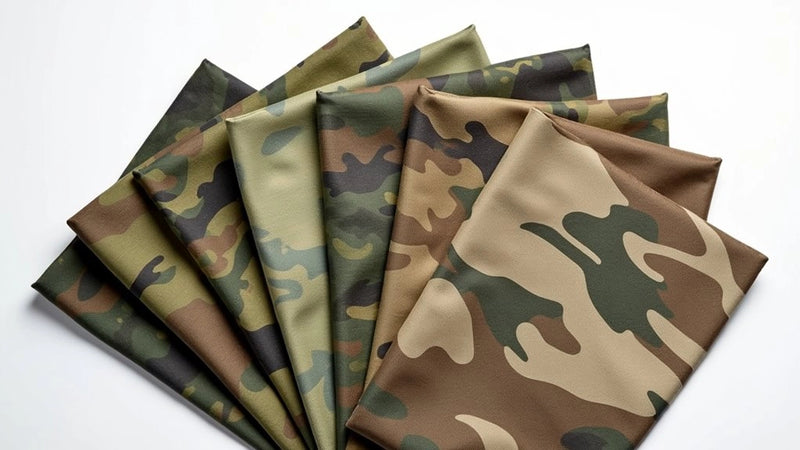
0 comments